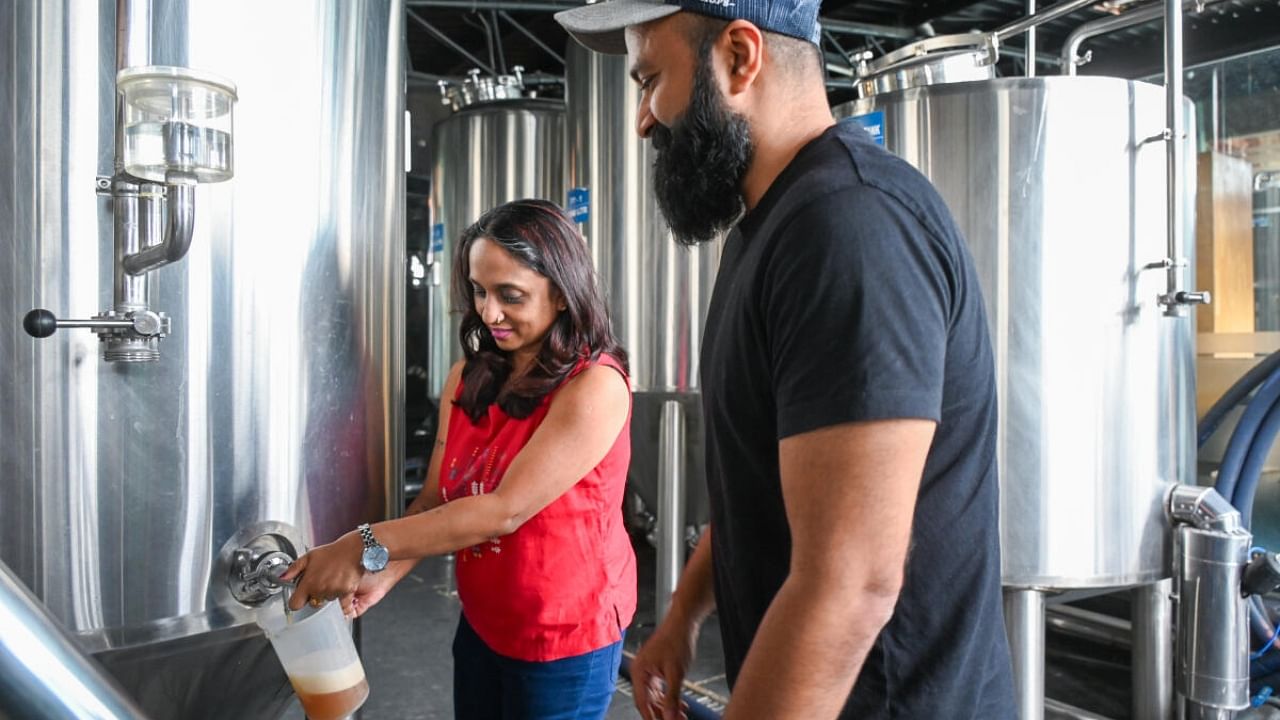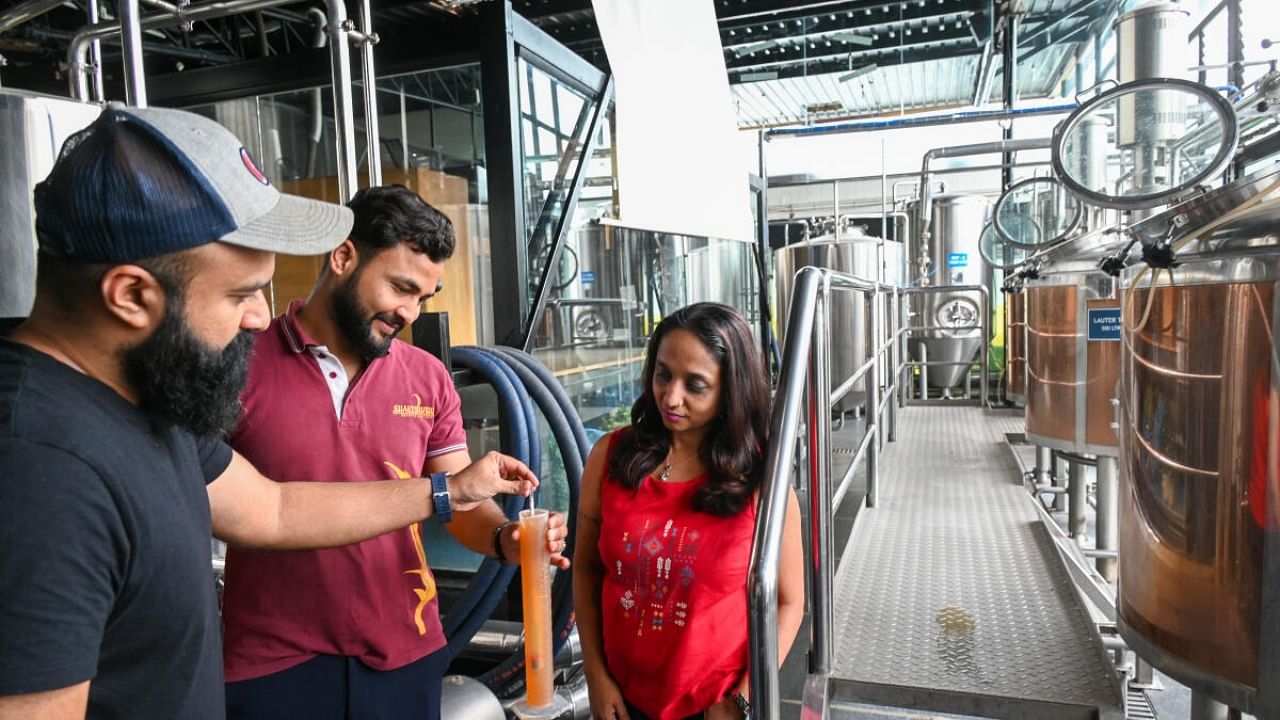

A beer or two is always on the agenda when I go visiting friends and family outside of Bengaluru. And I’m often accused of how picky I am when it comes to the beverage. Don’t get me wrong, I still love my good old Kingfisher. Like millions of others, it was my initiation into beer. Now, with Bengaluru witnessing an exponential growth of craft breweries, beginning around 2011 and today standing at around 80, I am spoilt for choice.
Bengaluru and beer go a long way back. Far beyond the Dewar’s, Ramadas, Black Cadillacs and Pecos of the world!
In his book, ‘Digesting India’, author Zac O’Yeah offers an interesting insight into the beer culture of Bengaluru during the mid-1800s. Ale was an expensive cargo to ship from England, he writes. Bangalore was the “biggest ‘English’ town in southern India, which was enough to warrant a beer industry”, he continues. According to Zac, there was
Castle Brewery, set up by a Scotsman in 1857, and Bangalore Brewing Company established during the 1880s. The two breweries along with three others located in the Nilgiris merged into what we now know as United Breweries. So clearly, the drink is part of the city’s DNA. This gave me some perspective.
Also Read: Brewing beer in Bayreuth
Is what we’re seeing with the burgeoning microbrewery business a reinvention — a new wave of beer if you will? Whether this is true or not, the role of the brewer, a single person responsible for what you get when you order your favourite pilsner or lager, is of paramount importance.
Having been in Bengaluru when the first breweries opened up, I remember most establishments having international brewers come in to set things up and brew the beer. That was back when we lacked the expertise.
But things have changed. The brewer community across the country today is qualified, talented, and innovative and brings what is most important to the craft — passion. Typically, a brewery has an in-house brewer or a consultant brewer (with multiple clients) or both.
Life of a consultant
I am an independent journalist and a consultant content developer. So, I was keen to understand how being a consultant works in the world of beer. I spent some time with Bengaluru-based Umang Nair, brewmaster and consulting brewer with clients in Bengaluru, Mumbai, Hyderabad, Bhubaneswar, Visakhapatnam and Guntur. He has been a brewer for 10 years.
Consultant brewers help set up brewing units in compliance with state laws. They make suggestions on vendors for machinery and ingredients, they are involved in the design of the unit, and help the investor understand the kind of beers that work at a chosen location. Besides brewing, they are also involved in quality testing, maintenance of the unit, training of the brewing team, interaction with wait staff, and sometimes, they work with the chefs for food and beer pairings. They also look into marketing and social media campaigns.
Consultant brewers visit their clients on a regular basis. On a Tuesday, I joined Umang on a visit to Shakesbierre Brewpub and Kitchen, off Brigade Road in Bengaluru. My aim was to observe him at work. As we were about to head into the brewery, a few excise officers walked in — it was time for the annual licence renewal, he told me. Such random checks are meant to ensure that the books tally on excise duty, inventory, sales and amount of beer in the tanks.
The process
Once the officials were done, we walked around the brewery that makes 500 litres per brew. I learned that the process starts with combining milled malt and hot water in a mash tun — to allow enzymes to convert starches into fermentable sugars. The resulting liquid is given the unappetising name ‘wort’. But I already know that this won’t keep me from a tall glass of witbier should the opportunity present itself!
The wort is then transferred to a kettle, where hops are added for bitterness, flavour, and aroma. After boiling, the wort is rapidly cooled before being transferred to a fermenter. Here, yeast is introduced to ferment the sugars, converting them into alcohol and carbon dioxide. The beer then undergoes a cold conditioning and maturing process before it is ready for the taps.
These days, craft beers are also sold in bottles. In an ideal world, this would have been the right moment to pick up a beer mug and try one of the brews. But I had to be patient. There was more work to be done.
We then began Umang’s weekly routine. First, we checked each of the beers on tap. We began with colour, to see if it was hazier, clearer or any different from the week earlier. Next, we examined the aroma — had it changed in intensity or were there any off flavours? An off-flavour arises if the draft line the beer passes through to reach the taps needs cleaning. Finally, we arrived at the tasting stage. This is usually done with the head brewer where there is one. I put my ‘business face’ on as I listened in on whether the best iteration was on hand or if the next batch had to be tweaked. Then came a session of tasting beers directly from the fermenters, just to ensure that the process was going as it should.
We went through a checklist to take stock of the equipment. This was followed by a sit-down with the brewery manager to discuss customer feedback. And finally, a meeting with the owner Bhaskar Baile to discuss possible collaborations, events and new beers. All this is done periodically.
Meter reading
I was taught to use the refractometer, an instrument to check the specific gravity (density of the wort), through which you can calculate alcohol levels in the beer. While a refractometer is used during the brewing process, the hydrometer is used during fermentation.
We then headed into the cabin on the floor, opening SCADA, a software that tracks and controls every aspect of the brewing process and the status of the machinery. Once done, we sat down to talk.
“Licensing laws vary in each state. As a consultant, I have to keep all those in mind when a new client approaches me,” Umang said. For example, in Karnataka, an establishment must have a minimum of 10,000 sq ft to open a brewery.
Taste test
It was not brewing day, so we proceeded to sample the seven beers on tap. I saw a mix of the classics and some experiments and got curious. Classics like the Belgian wit or a lager are often the most ordered. So, how does a consultant ensure that the classics in each of his breweries don’t end up being the same drink?
Umang explained that the basic ingredients of beer are malt, hops, yeast and water. “Belgian wits, for example, are light-coloured in the straw yellow spectrum. Different percentages of malts help change shades without breaking away from the classical style. Playing around with the hops, changing the aromatics, spices and even the yeast ensures no two Belgian wits in my portfolio are the same,” he shared. In some cases, the owners get involved in the creation, others are happy with what is done as long as the beers taste great. If they sell, there are no complaints.
Creative differences
Bhaskar tells me that brewers of Umang’s calibre tend to get into the finer details of classical beer styles. “I believe creativity should be in everything, including beers, and that’s where we have our differences,” he said, laughing with Umang.
They worked together to arrive at a middle path, balancing creativity and business in brewing. Giving me an example, Bhaskar explained the blueberry vanilla cream ale they have had on tap since 2019. “He groaned when I said let’s do something different,” recalled Bhaskar. But the ale was an instant hit and continues to be on tap.
Over the years, I’ve enjoyed several out-of-the-box craft beers like raspberry sour, rice lager, millet beer and black IPA. Some of these are brewer creations and others, a result of collaborations which, brewers like Umang believe, are a great way to bring in something new for the consumers and to facilitate an exchange of ideas.
Prasanna Kumar’s brewery in J P Nagar serves one such collaborative beer, the Milkshake Fruited Sour Ale that Umang worked on with master brewer Chaitanya Khanapure from Mumbai. “We smashed together different styles and arrived at something we liked,” Chaitanya told me on a phone call.
Facilitating collaborations
I distinctly remember the furore that a proposed beer cocktail by a Delhi pub caused in 2019 when it said it was making India’s first female beer and that it would be ‘sweet and mild’. The idea of a gendered beverage did not fly. That was just one cocktail, so how does a brewery owner green-light experimentative beer brewing without harming the RoI?
“Fortunately, all our collaborative beers have done well,” said Prasanna. “Working with a consultant who does not take advantage of the space or money at his disposal helps,” he added.
Umang explained that when collaborating on unique brews with expensive ingredients, the team aims to keep the pricing in check. “If the collaboration happens at our brewery, we provide ingredients, and the partners handle marketing. Or collaborators from other states bring their regional ingredients. During R&D, we quickly assess what works and what doesn’t, saving time,” he said.
But things may not always go as planned. Rituraj Raizada, partner at a brewery in Electronics City, told me, “We brewed a dark lager that was not moving as fast as we hoped. However, we had a library of ideas built from all the content Umang shared with us. We recalled reading how vanilla was used to make a stout beer more dessert-like and arrived at a combination of vanilla and orange for our beer, turning it something guests loved.”
Learning the basics
Training other brewers is an important part of the job. Typically, they are started on a three-month rigorous schedule of cleaning and maintaining the brewery. “If they get past this phase then you know they have the grit to take on the pressures of brewing,” Umang said.
Vivek Patel, currently lead brewer at a brewery in Hyderabad, worked with Umang for five years. He said, “He (Umang) did not just give me a recipe but brewed with me and made sure I understood the whole process.” Vivek was planning to sign up for a brewing course but after learning on the job, he believes his knowledge is “par for the course”.
Even beer enthusiasts are well-informed these days. Does it get hard to please them? “I believe beer is subjective and customers know beers from different places. Beer drinking is about the entire experience, the service and the food too. There will be differences in recipes, just like a chef’s approach to his food. That’s why breweries have 6 to 8 taps — something for everybody,” said Umang.
Talking about the future, Umang said, “Commercial craft breweries that produce large volumes consistently will be a reality soon and there will be a ceiling in terms of growth for most brewers. This, in turn, brings in opportunities for exploring various other brewery departments such as quality control, cellar and logistics, etc.”
As I poured a beer from the tap as I had been taught, he said, “I want the industry to grow — you need good men and women and for that to happen, they need to learn.”
Observing Umang interact with brewery owners, train wait staff, answer messages from brewers he is collaborating with or mentoring and knowing that he can be woken up in the middle of the night should equipment fail to come up with a solution, showed me that life of a brewer is more than just clinking glasses of beer.